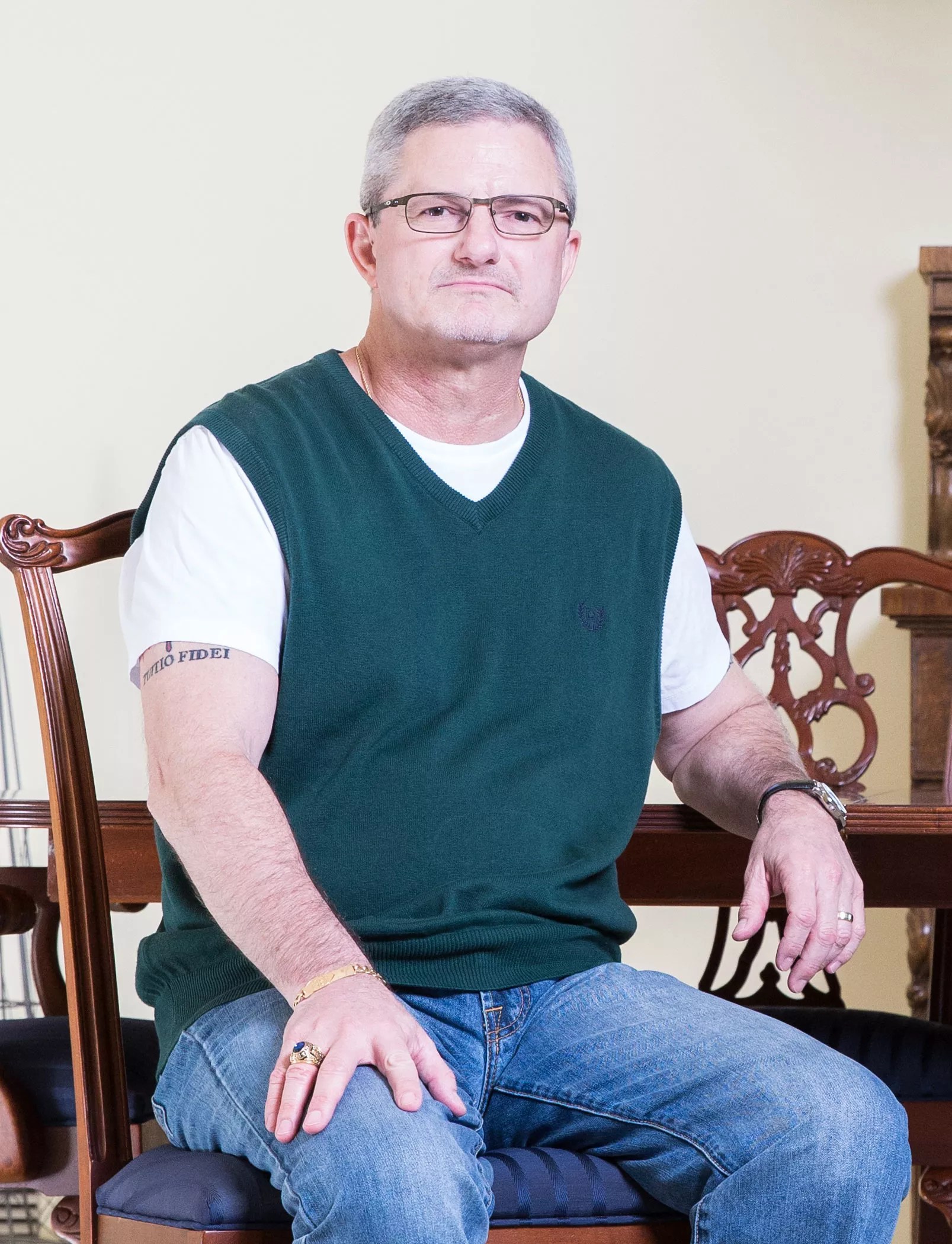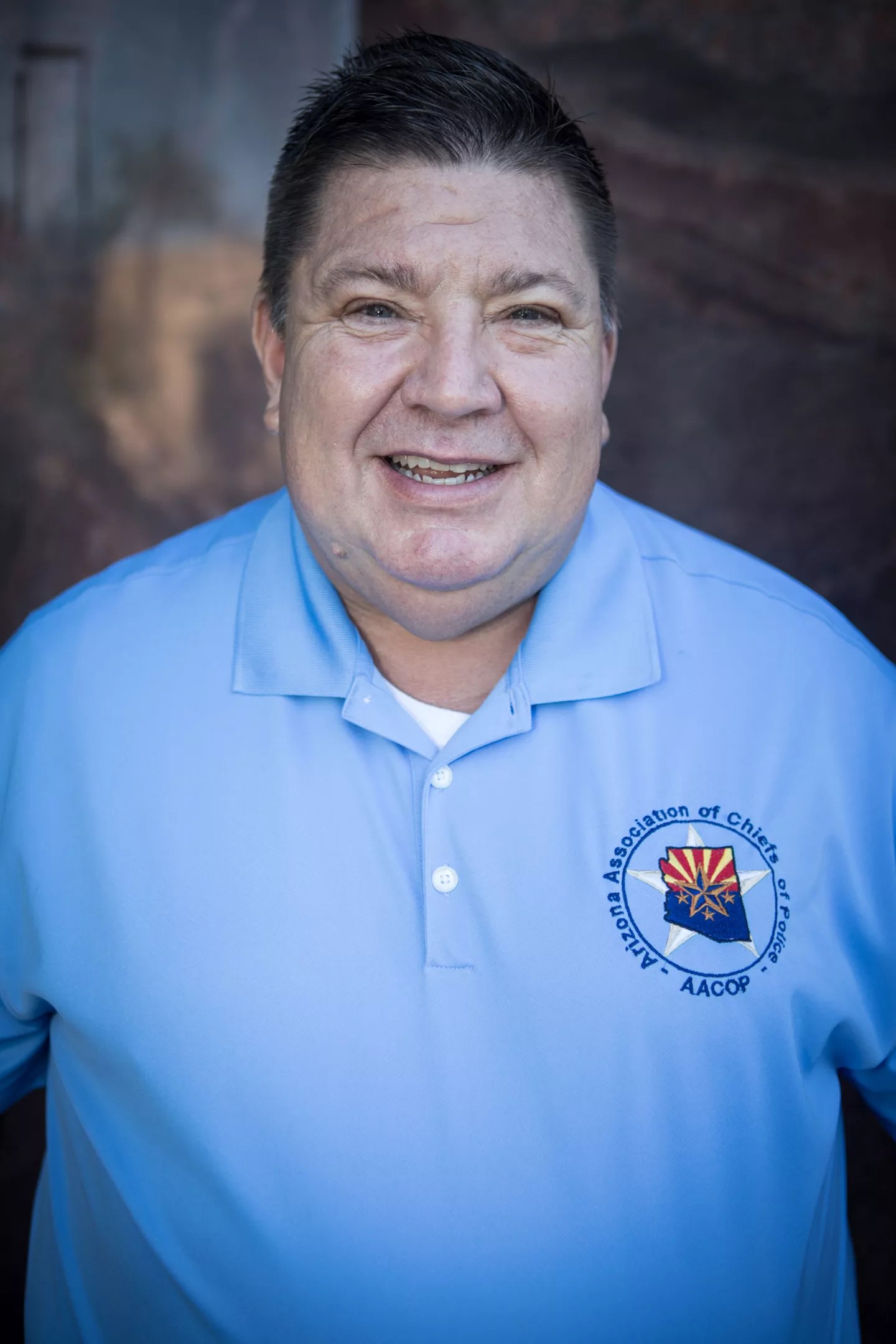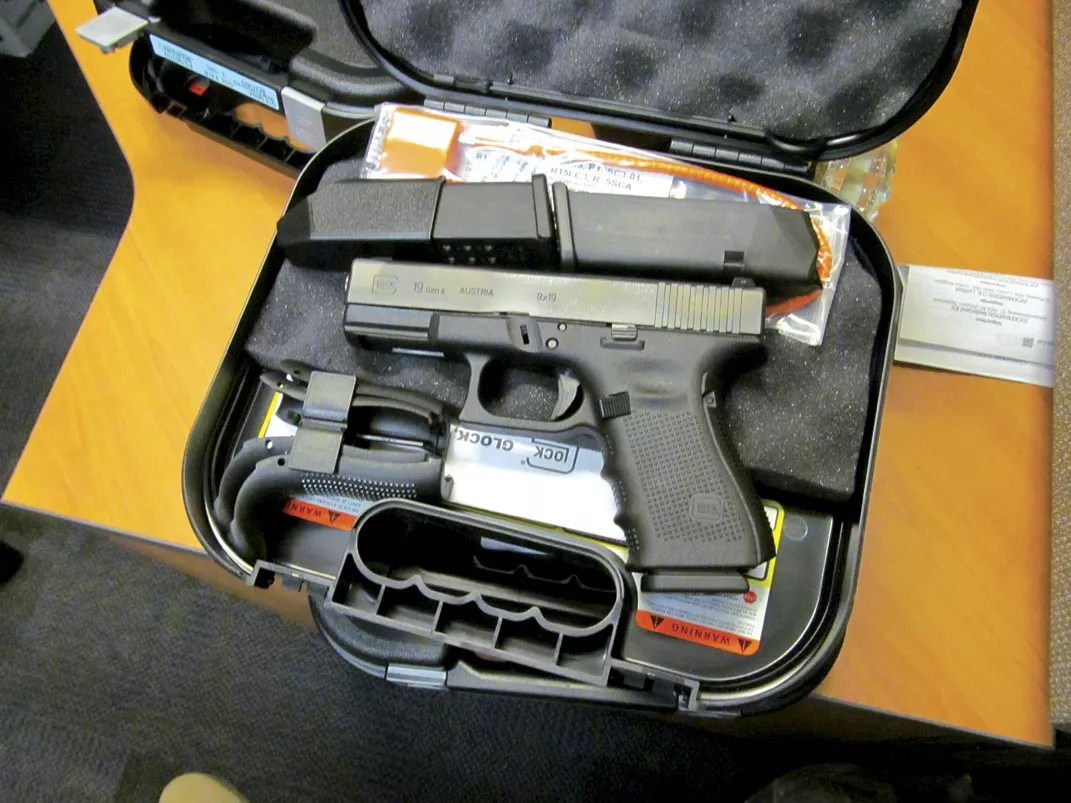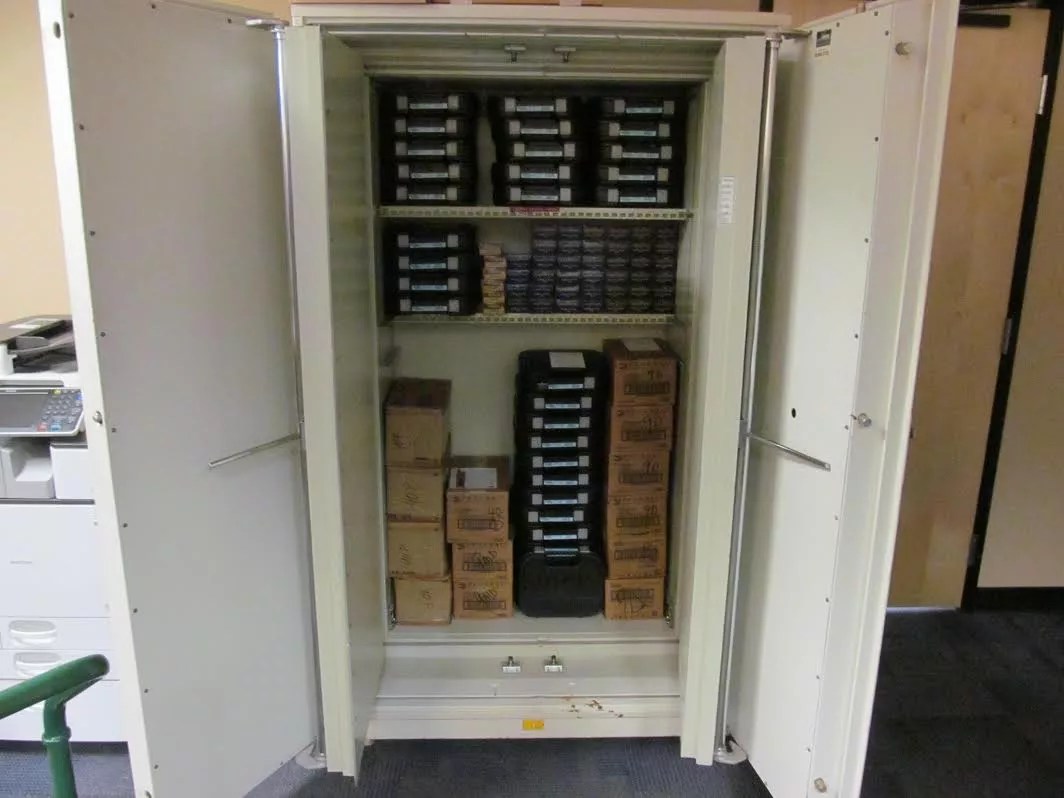
New Times

Audio By Carbonatix

New Times
The team of state troopers rolled up in their vehicles to the Arizona Department of Economic Security administration building after lunch on the day before Thanksgiving.
A dozen or so men and women emerged from the vehicles, ready to face the possibility of gunfire from the multiple armed men they were seeking.
The DES building, located a couple of miles southwest of Phoenix’s small collection of downtown skyscrapers, is a long, four-story concrete structure that looks fairly soulless — except for the brightly colored concrete balls set just outside the building in three locations as vehicle barriers.
Several of the balls seemed particularly out of place at an otherwise-sterile, state-government building: Painted sun-yellow, three sported an eternally happy smiley face; another was stenciled with the words “Be Awesome.”
The team of eight or more troopers, plus three or more supervisors including Lieutenant Heston Silbert, the No. 2 man at the state’s Department of Public Safety, moved past the smiley face and other bollards into the building.
The troopers’ mission: Help Governor Doug Ducey get rid of the unusual man he had appointed the year before to lead the DES, and who had turned the large state agency into a media sideshow.
To some extent, the firing of DES Director Tim Jeffries and his top staff on November 23, 2016, looked more like a police raid than an administrative change.
But Jeffries was believed to be keeping a gun at work against state policy. Two of his aides who were on the list to be fired were also considered by Ducey’s office to be armed and possibly dangerous, including chief of staff Clark Collier and DES Inspector General Jay Arcellana.
Beyond that, the troopers expected to find dozens of weapons and tens of thousands of rounds of ammunition that had been amassed by the agency under Jeffries.
Some officials at Ducey’s office and the state Attorney General’s Office were afraid that Jeffries was building his own police force, which they feared would act outside of normal DES responsibilities.
Silbert’s orders were to conduct a search and seizure of weapons and ammo “not already assigned to DES employees,” and escort the fired personnel out of the building. Rumor had it that the DES could not account for a large amount of the ammunition.
Silbert received a call from the governor’s office that morning to launch the raid, according to Charles Loftus, then the DES director of security.
Loftus said the DPS supervisor told him there was no advance notice of this.
Silbert, however, said through a spokesman that he has no recollection of such a conversation with Loftus.
The troopers swarmed the building and escorted Jeffries and the others out past stunned DES employees. They took no photos or video of the executives’ ejection.
Silbert went to the posh home in Scottsdale that Jeffries shares with his wife, Mary Francis, to retrieve a .40-caliber Smith & Wesson M&P semiautomatic handgun bought with state money.
Collier, a retired Peoria police commander, was escorted to his home to give up his 9 mm Beretta NANO semiautomatic pistol.

Tim Jeffries filed a .1 million claim against the state this month, saying an audit of the guns and ammo contained lies.
Deanna Dent
Arcellana was the only one of the three executives who had his gun, a .38-caliber Smith and Wesson revolver, at the office. Jeffries’ executive assistant, Marie Barker, and human resources officer Morris Greenidge were also terminated.
Troopers located the arsenal in three different locations of the expansive DES headquarters building. A safe on the fourth floor held dozens of handguns “chambered” and ready for action. In the basement was a large cache of 84,550 rounds of 9 mm, .40 caliber, and .38 caliber ammunition.
The troopers loaded the weapons and ammo into an SUV and took them to a DPS armory. Before doing so, though, they took numerous photos of the firearms and ammo.
The pictures, which were later released to the media, show that some of the ammunition in the basement wasn’t stored properly. Boxes of ammo were piled against walls and under desks in an unused office, as if put there by a sloppy gun-show salesman.
When news of the weapons cache broke, a firestorm of media coverage followed.
The arsenal was the biggest story of an already sizable flurry of press made by Jeffries during his reign as director.
The media loves a good anti-gun story, as this seemed to be. The arms buildup at the DES was widely covered and criticized.
To many, it appeared that the DES — a state agency charged with helping people — had gone gun-crazy.
Back in December 2015, long before that tough day for Jeffries, Syed Rizwan Farook, an environmental health specialist for San Bernardino County, California, sat in attendance at a training meeting for county employees.
The Inland Regional Center, run by a nonprofit agency to help people with developmental disabilities, had been rented out specifically for the training event.
Farook left the meeting and came back with his wife, Tashfeen Malik, both dressed in all-black tactical gear and wielding semiautomatic rifles.
“In a matter of minutes, the couple fired over 100 .223 rounds, wounding 22 and killing 14 before they fled in a rented SUV,” said a detailed, online review by law enforcement of the incident.
Farook and Malik were quickly identified, chased down by cops, and killed in a hail of bullets.
The lone-wolf-style attack, apparently rooted in jihadist zealotry, left a profound impression on Jeffries, the brother of a murder victim and a deeply religious man.
Ten months earlier, Ducey had appointed Jeffries to head the state DES, which has 7,700 employees and oversees various state and federal social-service programs with a $2.5 billion annual budget.
In his mid-50s, with a preacher-like personality, Jeffries fell into Ducey’s favor because of his skills in the world of business; he had little experience in government or social work.
Jeffries knew he had the heart for the job — that it dovetailed with his lifelong goal to become the best Catholic he could be. Believing that others could benefit from his religion, he regularly infused his devout Catholic faith into the workplace. He hung a crucifix above his door and proclaimed himself a proud member of the ancient Order of Malta. He inserted religious messages in agency-wide emails and presentations to employees, irking some workers and creating division at the agency.
His style developed a strong following of supporters as well as critics during his time as director. According to some metrics, he improved morale and efficiency at the agency. Throughout 2015 and much of 2016, Ducey did nothing about the media reports of callous mass firings of hundreds of employees under Jeffries. The governor, through a spokesman, said he wanted to “clone” Jeffries.
But Jeffries’ enthusiasm for his new job in social work had a dark side. His bubbly personality had an edge of paranoia, especially with issues like personal safety — and Islamic terrorism.
No one should have been surprised by the DES security boost, which involved a truckload of new weaponry.
Months before his firing, in the aftermath of terrorism in San Bernardino and overseas, Jeffries had announced the reason — quite publicly — for creating a new security force at the agency.
He was trying to protect his flock of DES colleagues from “merciless evil.”
The December 2015 attack on the county training meeting in California triggered Jeffries to ramp up not only the investigation arm of the DES Office of Inspector General, but also a larger, non-sworn force of internal security guards.
In January, at the 2016 DES Leadership Summit, Jeffries had Collier, his chief of staff, speak about the incident to employees, reminding them of their leader’s concern for them.
A Facebook photo posted after the summit shows Collier and another man onstage, with slides projected in the background mentioning the attack in California and explaining that a “worker safety workgroup” had been planned since July 2015. “Visible officers in lobbies” were being considered, one slide read.
In San Bernardino County, a similar security increase occurred in direct response to the attack, according to county spokesman David Wert.
“We authorized departments to increase security staffing if they felt that was necessary,” Wert said.
In some cases, that meant adding guards, and in others, it meant arming guards, he said. San Bernardino currently contracts with the local sheriff’s office to provide deputies or oversee the operations of private security guards. Armed guards or deputies are stationed permanently at the county’s three largest facilities, he said.
Yet the new security in San Bernardino County wasn’t anywhere near as robust as what Jeffries had planned.
First, Jeffries set out to find someone to lead this expanded force. In late February 2016, he believed he had found just the right man: Charles Loftus.

Charles Loftus, hired to oversee the DES security ramp-up, is a bona fide law-enforcement expert.
Jim Louvau
On March 3, 2016, the DES issued a press release announcing Loftus as “director of security.” In the new position, Loftus would report directly to Inspector General Jay Arcellana and lead the new Security Unit.
Loftus was also to find a way to partner with police agencies to “enhance security presence and response at DES facilities,” the release stated. “His role will be to ensure safety at DES facilities statewide.”
Jeffries was quoted in the release saying, “The recent escalation of terrorist-like outbursts at public sites has made it clear we need to increase our efforts and … prevent similar incidents occurring at our facilities.”
Loftus is a retired Arizona State University police officer. As a campus cop, his experience in law enforcement was likely more limited than that of officers in municipal police departments. But he is an expert in law enforcement, having earned a doctorate in public administration/police and public corruption at ASU in 2005.
From 2008 to his hiring by DES, Loftus worked as an assistant chief agent at the Arizona AG’s office, overseeing the agency’s RICO forfeiture and anti-money-laundering units. He still works as an instructor at ASU’s criminology and criminal justice department, teaching classes like “Introduction to Policing” and “Domestic Terrorism.”
The AG’s office tells Phoenix New Times that Loftus left the agency in good standing, with no stains on his record.
Jeffries had sat in on one of Loftus’ interview meetings and liked him right away. In addition to his extensive qualifications, Loftus fit right in with the quirkiness of the Jeffries administration.
He claims, for instance, that he, and not Jeffries, came up with the motto for the planned upgraded security force — “Samaritanus Protectores.” The name evokes both the parable in the New Testament of the Good Samaritan and the name given by the ancient Romans to senior officers who were devoted to their emperor.
A few weeks after Loftus was hired, multiple suicide bombings in Brussels killed 32 people and injured more than 300.
Jeffries wrote to his flock the same day in an email leaked to New Times, calling what had happened the result of “merciless evil.”
“Effective immediately,” the March 22, 2016, email by Jeffries stated, “I am authorizing every colleague who feels compelled to carry mace and/or pepper spray to commence doing so on state property IF you are not already doing so. Furthermore, I will ask our DES Security Group to accelerate the review time frame to further expand the armed protection of our offices. So, stay tuned! Resolute!! Director J.”
The Arizona Capitol Times later reported that he was doubling the DES security budget to $1 million annually to help carry out his goals.
Loftus followed up in agency-wide emails, advising which type of Mace or pepper spray was best, and asking DES employees who previously worked in law enforcement if they wanted to sign up for a program in which they could carry firearms in their workplaces.
“Our goal is to provide a small group of highly trained individuals in our facilities who have the training and expertise in hostile situations,” Loftus wrote. “These are the colleagues who possess what is often referred to as the ‘Sheepdog DNA.’ They are often the co-workers who are willing to put themselves between you and potential harm.”
The New Times source who provided the emails expressed uneasiness about the new direction — and his criticism turned out to be a sign of things to come.
“I have instructed my wife,” he wrote, “if I am pepper-sprayed by some idiot or shot by some cowboy cop, to immediately file a lawsuit against Jeffries and Chuck Loftus.”
Loftus’ official designation when he was hired was deputy chief law enforcement officer. As such, he should have reported to DES’ chief law enforcement officer, the second-in-command under Arcellana, Terry Azbill.
But Jeffries and Arcellana didn’t like Azbill. He didn’t play on Director J’s team, it seemed. And he did not like how the security increase was being handled.
In August 2016, Jeffries fired Azbill. He won’t say why.
Arcellana and Azbill didn’t get along, as Arcellana makes clear.
Arcellana was a veteran employee and manager of the California Unemployment Insurance Appeals Board before he came to DES. He was fired by the board in 2008 after accusations of nepotism and causing delays in workers getting their rightful benefits. He blames it on politics, telling New Times he never did anything wrong.
But Azbill once wrote a letter to the governor’s office complaining about Arcellana’s California past and “giving them all this dirt on me” that wasn’t really dirt, Arcellana said.
Azbill was fired soon after because of his fitness level and because he was “lazy,” Arcellana claimed.

One of the 55 handguns purchased by the DES last year for a planned increase in armed security officers.
AZ DPS
According to Loftus, Jeffries and Arcellana decided by then not to partner with another law enforcement agency to expand security, but to do it themselves — and do it fast.
At the time, DES had been contracting with up to eight private security firms to provide guards at the agency’s 100-plus satellite offices around the state.
Loftus said the state had agreed to the new program, which he said would save taxpayers “hundreds of thousands” of dollars while providing better security for employees and the people who visit DES offices.
He figured he needed to hire 72 new non-sworn security officers, in addition to hiring a few extra sworn OIG investigators, and outfitting 15 of the ex-law enforcement “sheepdog” types, among others.
He was going to need guns — a lot of them — and a ton of ammo for training.
Jeffries told him he wanted the expanded security in place by the end of 2016. But Loftus realized that to make Jeffries’ dream come true, he had to act even sooner.
Loftus was intensely worried that, as polls showed at the time, Hillary Clinton was going to become the next U.S. president. And that would mean a scarcity of ammunition, just as there had been under Barack Obama when people stocked up on gun supplies, thinking gun-control measures were imminent.
Loftus said he fretted that if he couldn’t please Jeffries, he might end up one of the hundreds of vanquished employees fired in the director’s “same-day exit” program.
“I couldn’t risk not having everything in place before the end of the year,” he said. “I just didn’t want to fail.”
Firmly believing that Clinton would cause problems for him and the security plan, Loftus oversaw the rapid purchase of several dozen handguns and tens of thousands of rounds of ammo.
Phoenix police and state DPS officials tell New Times they didn’t take the presidential election into account when planning ammunition purchases.
It turned out they didn’t need to, of course: Donald Trump was elected, and sales of guns and ammunition have plummeted nationwide.
Loftus’ hasty ammo purchases also ran afoul of state procedures. About two-thirds of the ammo was purchased through suppliers not contracted with the state.
The procurement violation could have been a misdemeanor crime. But in a confusing twist, officials say they have no idea how the violation occurred, or who was responsible.
Loftus even bought 2,900 rounds with his own money for his new troops to practice with, then got the state to reimburse him. One of the purchases was within state code, but another — at Cabela’s in Glendale — was not.
But Loftus said both of those purchases were proper because he filed an emergency waiver for them. He said he had more than seven non-sworn guard trainees collecting paychecks but unable to train at the range because, at the time, the DES had no ammo for them.
Still, Azbill, who was rehired as DES chief law enforcement officer in November, after Loftus was fired, believes the security ramp-up was less about safety and more about Jeffries’ paranoia.
Azbill later told a state investigator that although he had purchased some of the firearms and ammo, he knew nothing about breaking any purchasing protocol. Asked why DES had obtained so much ammunition, Azbill said Jeffries and Loftus, “were on a mission to arm every DES employee.”
If any violation of the rules occurred, “it was done so at the direction of Jeffries because he was crazy and wanted to speed up the process,” Azbill said, according to the investigator.
Jeffries acknowledged that, during summer 2016, he spent time at the Scottsdale Gun Club range with his state-issued Smith & Wesson .40-caliber.
The former DES director said he went through 200 rounds bought with public money, and another 400 rounds he bought himself.
His aim was dead-on, he said — though he saved no records or targets to prove the claim.
He said he had issued himself the gun as a “loan,” along with 200 rounds of ammo, because he wanted to become familiar with the gun used by some of the new officers being hired. He added that Arcellana gave him the gun, unloaded, in a case in his office, and that he brought it home that day, never again having it at work.
“I felt compelled to become knowledgeable and proficient of the very weapon these sworn officer and security guards were carrying,” he said, although in fact the guards use 9 mm handguns. “Many of them thought it was awesome that I cared enough about them to train on the [same] weapon.”
Jeffries gave another reason to the news media late last year, saying that he carried a gun because he’d received death threats. But he denied he ever violated policy by carrying a gun at work.
DES Sergeant Dale Doucet claims the motives of his former boss were less than wholesome. He said Jeffries used the security boost to satisfy his itch for recreational target shooting on the public’s dime.
“Jeffries and Loftus would regularly take ammunition from the DES inventory to shoot from their state-issued handguns at a private range,” Doucet told a DPS investigator. “On an almost weekly basis, Jeffries and Loftus would openly proclaim they were going to the range to shoot DES ammunition, even leaving work early to do so.”
Neither Azbill nor Doucet returned messages for this article, but their feelings and statements about the guns and ammo buildup appear in a 783-page report on an audit conducted by DPS inspector Christopher Luebkin after Jeffries’ firing.
Jeffries scoffed at Doucet’s claim: “That is a fucking lie.”
As Luebkin discovered, all of the 55 handguns found by DPS in November had been properly purchased under Arizona Procurement Code.
The guns were rightfully purchased to equip 28 armed security officers, 23 sworn law enforcement officers, and three DES employees — Jeffries, Arcellana, and Collier, Luebkin wrote in his report.
“The number of firearms in the DES/OIG inventory were appropriate for current staffing, and the types of weapons were appropriate to the DES/OIG mission,” Luebkin wrote in his report.

Several boxes of ammunition found at the DES in November were stored insecurely in a basement office, DPS photos show.
AZ DPS
The guns had also been stored adequately in a safe.
Loftus, in an email to state officials, wrote that 33 of the 55 guns had been assigned to guards who had already been hired, and 17 more guards were expected to be hired in December, leaving five “spares.”
The biggest problem in terms of the guns themselves were the three guns bought for Jeffries, Arcellana, and Collier, Luebkin wrote, because the executives were not allowed to carry guns on DES property, according to DES policy.
Yet in his report, Luebkin didn’t attempt to back up the claim that the executives carried guns at work with any evidence, such as witness accounts.
Jeffries is firing back at the accusations against him in Luebkin’s report. Earlier this month, he filed a $5.1 million libel claim against the state.
Besides the allegations of carrying a gun at work and shooting on work time, he denied that he wanted to arm every DES employee, “wanted to create his own police force and control it,” or had anything to do with ammunition purchases and storage.
His attorney, former state Attorney General Tom Horne, said that Jeffries will file a lawsuit if the state doesn’t settle the claim.
Last week, Loftus served his own notice of claim against the state, alleging that most of the allegations against him in the DPS report are false, and that Luebkin intentionally wrote lies.
“The author of the report, for whom the State is liable, maliciously wrote falsehoods, including falsely reporting what he had been told by witnesses, including me.”
The claim says that Loftus will settle for $2.6 million.
Christopher Luebkin’s long-awaited report, in fact, became part of the DES gun scandal even before it was released to the public.
He finished his report in mid-February 2017, according to the DPS. It was scheduled to be released immediately, but something held it up.
Jeffries and Loftus believe it was delayed so their enemies at the Governor’s Office would have more time to gin up a case against them — and to justify the heavy-handed November 23 raid at the DES building.
The audit report was finally made public in mid-July.
Dennis Young, the current DES inspector general, didn’t return a call. DES officials — including the current director, Michael Trailor — refused to speak about the matter even before Jeffries filed his libel claim.
Oddly, Luebkin never interviewed Jeffries, Arcellana, or Collier for his audit.
He didn’t interview Loftus until mid-May, and that interview came about only because Ducey aide Henry Darwin insisted on it.
“As you have seen, I have chosen not to respond to your numerous emails,” Darwin, then the DES interim director, told Loftus in a May 19 email. “I am going to make this sole exception because I think you should know the real reason for the delay in finalizing the report. … I recognized that it was highly critical of actions you had taken, but you had not been interviewed. I believed that without such an interview, the report was incomplete and possibly inaccurate. So I returned the draft report to DPS and requested that you be interviewed before finalization of the report.”
Darwin continued, referring to some of the glib remarks by Loftus in his emails: “If you choose to view this as a ‘cover-up’ or me as an ‘Inglorious Bureaucrat’ for seeking all sides of the story before issuing a public report, so be it. Good day, and please never contact me again, as this will be the one and only communication I ever have with you.”
Luebkin’s revised report condemns Loftus for buying so much ammunition. If Loftus had been able to execute the plan to hire more than 70 armed guards and six more sworn officers, and to arm the ex-police DES employees, the rounds he ordered would have averaged 844 rounds per employee, Luebkin wrote.
Luebkin noted that DPS troopers use 500 rounds per trooper, annually, and Phoenix police officers use 500-700 rounds on average, per officer.
“Thus, the amount of ammunition purchased by the [DES] may be reasonably described as excessive,” Luebkin concluded.
Yet “excessive” is relative.
In a 2013 article in American Rifleman about the Obama-era ammo shortage, writer Frank Miniter quotes Georgia Congresswoman Lynn Westmoreland saying that the Department of Homeland Security planned to use “only about” 1,400 rounds per employee, per year for training over the next few years.

One of the safes that stored dozens of firearms purchased by the DES. A DPS audit said the firearms – though not necessarily the ammo for them – had been bought and stored properly.
AZ DPS
Loftus said the planned per-officer average of 844 at the DES also took into account expected attrition of the security staff — in other words, some guards would have been recruited and trained on the shooting range, but would have ended up quitting soon after.
The main problems with the ammunition, as Luebkin detailed, were how it was bought, the insecure way some of it was stored in a locked basement office, and the poor record-keeping of how the bullets were used.
Ultimately, Luebkin wrote, 4,050 rounds could not be accounted for. But the DPS investigator does not accuse Loftus or anyone else of stealing the rounds or using them to go shooting on personal time.
The problems could be chalked up to something routine but rather unexciting: plain, old government incompetence.
Luebkin’s report raises nearly as many questions about the problems as it answers.
For instance, DES officials held numerous firearms qualification events at shooting ranges for current employees and some of the new hires in 2016.
But records of how much ammo was used, who shot it, and whether employees qualified with their firearms or not, apparently never existed. Or maybe they did exist, as Loftus and others claim, but they haven’t yet been found.
Or maybe, as Chief Law Enforcement Officer Terry Azbill told Luebkin, they were recorded diligently on sheets of paper kept in a binder.
Azbill told Luebkin he suspects those records were shredded by someone — he didn’t know who would have done it, or why.
Retired state trooper Bill Shantz, a state-certified police firearms instructor who contracted with the DES to help train employees, told Luebkin that he kept detailed records of the shooting-range activity and gave a notebook with the records to OIG Internal Affairs Sergeant Bill Foldesh.
Foldesh told Luebkin he didn’t remember ever seeing such a notebook, or receiving one from Shantz.
Luebkin quotes Foldesh extensively in his audit report about DES training and policies. Yet Foldesh told New Times that many of the statements attributed to him in Luebkin’s report are “100 percent fabricated.”
“The audit itself was nothing but a bunch of BS,” Foldesh said. “It was not based on facts. … There’s a whole lot more to the story.”
But Foldesh did not elaborate, later declining to answer a list of questions by New Times.
It’s unclear if such poor record-keeping may be endemic to other state offices. Last month, the governor’s office reportedly ordered a review of all the firearms and ammunition issued to other state agencies that employ sworn or non-sworn armed officers, like the Department of Liquor Control.
Luebkin’s claim that a procurement crime occurred is, likewise, a murky one.
Luebkin doesn’t accuse Loftus, Jeffries, or Azbill directly of violating the law — indeed, Loftus and Azbill denied that they oversaw the purchase of any ammunition outside of those allowed by state contracts. But someone ordered tens of thousands of rounds from Gans Industries, which is not a state-approved supplier.
Although Loftus “initiated” the purchase from Gans, he said one of the “procurement girls” suggested the company to him, and that he had no idea the company wasn’t approved.
Luebkin interviewed only one person from the DES procurement office, Patty Clark, but evidently didn’t ask her how the off-contract purchases were made.
He did, however, interview Lori Noyes, the DPS procurement officer, who was not involved with the DES ammo purchases. She said it appeared someone circumvented normal procurement procedures to buy tens of thousands of rounds from suppliers not contracted with the state. But she said she had no idea how that happened. Nor would anyone ever know “short of a confession.”
That explanation raises several questions, such as how — in this computer age — the system could be bypassed without any evidence of the crime or who did it. Noyes refused to talk to New Times about her statements in the report.
And the Arizona Department of Administration rebuffed a request for clarification on how the procurement system works, how it could be bypassed so mysteriously, and whether such problems are rampant across state agencies.
New Times requested an interview with Luebkin in late July; the DPS said he was not available because he was on a bereavement leave. After Jeffries filed his $5.1 million claim, the DPS and other state agencies declined comment altogether on the gun issue.
In any case, officials at the DPS and the DES had previously said that the responsibility for pursuing the alleged misdemeanor procurement crime lies with the state AG’s office.
AG Mark Brnovich’s office declined comment on whether prosecutors would take any action.
The issue of hoarding guns and ammo wasn’t mentioned when Ducey fired Jeffries and his team — in fact, the governor’s office has never stated specifically why Jeffries was fired.
Although the governor’s office had announced Jeffries’ unceremonious departure when it happened, news of the weapons find was kept secret until November 30, when a Ducey aide told the Arizona Republic about it.
The story went viral, and some pundits weighed in with heavy criticism.
“The state of Arizona is lucky they ejected this guy from office (and disarmed him and his team) before a tragedy occurred,” wrote Francis Langum of CrooksandLiars.com. “I didn’t mention what political party Jeffries belongs to because I don’t have to, do I?”
The site PhxSux.com described the weapons as a “Waco-level arms cache” in an article by Robbie Pfeffer titled, “Thank Idiot Doug Ducey For Giving Us Psychos Like Tim Jeffries.”
“So, you may ask yourself, how many bullets are needed at the DES office?” Pfeffer wrote. “According to Jeffries, the answer is at least 80,000. (which is 80,000 more than I would have anticipated.)”
One aspect of the DES gun story that made it so tasty for the media was the insignia that Jeffries approved for 300 beige uniforms that were to be worn by the internal security force.
Stitched on the back of the uniforms was a small, yellow smiley face — Jeffries’ favorite symbol.
After he was fired, the state spent $807 to cover up the smiley faces with Arizona flags.
But the uniforms have been kept by the DES — because the internal security force created by Jeffries and Loftus will continue at the agency, though for now on a smaller scale.
Some of the uniforms’ unusual insignia will remain, too, such as the state’s motto, “Ditat Deus,” (God Enriches), and the made-up, quasi-religious phrase, “Samaritanus Protectores.”

An example of the smiley faces that Jeffries ordered stitched to the backs of 300 DES security-officer uniforms. They have been replace.d
DES
Reynolds Nejo, the current head of the DES OIG security-officer force, tells New Times that the phrase and what it stands for remains at the heart of the internal security program. Nejo helped Loftus and others involved in the security increase draft policies and procedures for the expanded force — policies which, by the way, Luebkin found orderly and proper.
“We protect life, protect property, and protect process,” Nejo said. “This is the one standard that we are training to. … We are the saving grace.”
Nejo said he believes more security is necessary for employees and clients at DES offices. In early July, he said, a DES guard had to pull a gun on a client who threatened the guard with a “club.” Some of the satellite offices are located in rough areas.
“People come in with machetes,” he said.
Last year, DES records show, at least 86 cases of disorderly conduct were recorded at the agency’s satellite offices, along with 32 “threats” and various cases of criminal damage, trespassing, domestic violence, and other crimes. “Weapons” were noted as a problem in only three of the cases.
The security-officer unit currently has 23 officers and five supervisors, he said, but a hiring freeze has been in place since Jeffries’ termination. Nejo’s not sure a total of 70 are needed — he believes in a more surgical approach, examining the problems in each of the offices and staffing them with state-hired and state-trained security officers as needed.
That means the DES will eventually burn through its existing store of bullets, which have been returned to the DES. And they’ll have to buy more.
Luebkin’s report notes that in February, all of the OIG officers and protective security details were taken to the range to see how they shoot.
“Every employee who attended the shoot passed the firearms and judgmental qualification,” Luebkin wrote.
The current staff of DES’ sworn and non-sworn officers would appear to have been well-trained.
The security plan is “still workable,” said Nejo, a former commander at the Gila River Indian Community police department and intelligence officer at the state Department of Gaming. “It could be a good way to protect clients and staff.”
The smiley-face concrete bollard in front of the DES headquarters has been painted over.
But Jeffries’ fear of terrorism and desire to keep employees safe perseveres.

Brightly colored bollards at one of the entrances to the DES headquarters in Phoenix, as they appeared in November 2016. The yellow smiley-face, one of three such bollards at the building, has since been painted over.
AZ DPS